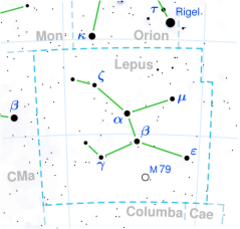Astronomy:Epsilon Leporis
| Observation data Equinox J2000.0]] (ICRS) | |
|---|---|
| Constellation | Lepus |
| Right ascension | 05h 05m 27.66537s[1] |
| Declination | –22° 22′ 15.7239″[1] |
| Apparent magnitude (V) | +3.166[2] |
| Characteristics | |
| Spectral type | K4 III[3] |
| U−B color index | +1.783[2] |
| B−V color index | +1.478[2] |
| Astrometry | |
| Radial velocity (Rv) | +1.0[4] km/s |
| Proper motion (μ) | RA: +21.13[1] mas/yr Dec.: –73.11[1] mas/yr |
| Parallax (π) | 15.5999 ± 0.1074[5] mas |
| Distance | 209 ± 1 ly (64.1 ± 0.4 pc) |
| Absolute magnitude (MV) | –1.02 ± 0.10[6] |
| Details[6] | |
| Mass | 1.70±0.19 M☉ |
| Radius | 40.1±3.2 R☉ |
| Luminosity | 372[7] L☉ |
| Surface gravity (log g) | 1.43±0.09 cgs |
| Temperature | 4,131 K |
| Metallicity [Fe/H] | –0.02 dex |
| Age | 1.72±0.47 Gyr |
| Other designations | |
| Database references | |
| SIMBAD | data |
Epsilon Leporis, Latinized from ε Leporis, is a third-magnitude star in the southern constellation Lepus. The apparent visual magnitude of +3.166[2] places it third in brightness among the stars in this constellation. Based upon parallax measurements, it is located at a distance of around 213 light-years (65 parsecs) from Earth.[1]
This is an evolved giant star with a stellar classification of K4 III[3] that has expanded to 40 times the Sun's radius. It is about 1.72 billion years old and has 1.70 times the mass of the Sun, with a luminosity 372[7] times as great. The outer atmosphere is cooler than the Sun's with an effective temperature of 4,131 K,[6] giving it the orange hue of a K-type star.[9] In terms of its composition, this star shows a similar abundance of elements other than hydrogen and helium to the Sun.[6]
The envelope of this star is undergoing oscillations that show up as changes in the star's radial velocity. Over long durations these follow a linear trend, in combination with shorter period oscillations occurring over a few days. These oscillations are unlikely to be the result of rotational module as that would imply a high rotation rate, which would display itself through strong X-ray emissions. Instead, they may be the result of solar-like and Mira-like oscillations.[10]
References
- ↑ 1.0 1.1 1.2 1.3 1.4 van Leeuwen, F. (November 2007). "Validation of the new Hipparcos reduction". Astronomy and Astrophysics 474 (2): 653–664. doi:10.1051/0004-6361:20078357. Bibcode: 2007A&A...474..653V.
- ↑ 2.0 2.1 2.2 2.3 Gutierrez-Moreno, Adelina et al. (1966), "A System of photometric standards", Publications of the Department of Astronomy University of Chile (Publicaciones Universidad de Chile, Department de Astronomy) 1: 1–17, Bibcode: 1966PDAUC...1....1G
- ↑ 3.0 3.1 Houk, Nancy; Smith-Moore, M. (1978), "Michigan catalogue of two-dimensional spectral types for the HD stars", Michigan Catalogue of Two-dimensional Spectral Types for the HD Stars (Ann Arbor: Dept. of Astronomy, University of Michigan) 4, Bibcode: 1988mcts.book.....H.
- ↑ Wielen, R. et al. (1999), "Sixth Catalogue of Fundamental Stars (FK6). Part I. Basic fundamental stars with direct solutions", Veröffentlichungen des Astronomischen Rechen-Instituts Heidelberg (Astronomisches Rechen-Institut Heidelberg) 35 (35): 1, Bibcode: 1999VeARI..35....1W
- ↑ Brown, A. G. A. (2021). "Gaia Early Data Release 3: Summary of the contents and survey properties". Astronomy & Astrophysics 649: A1. doi:10.1051/0004-6361/202039657. Bibcode: 2021A&A...649A...1G. Gaia EDR3 record for this source at VizieR.
- ↑ 6.0 6.1 6.2 6.3 da Silva, L. et al. (November 2006), "Basic physical parameters of a selected sample of evolved stars", Astronomy and Astrophysics 458 (2): 609–623, doi:10.1051/0004-6361:20065105, Bibcode: 2006A&A...458..609D.
- ↑ 7.0 7.1 di Mauro, M. P.; Cardini, D. (October 2006), "Asteroseismology of K giants", in Fletcher, Karen; Thompson, Michael, Proceedings of SOHO 18/GONG 2006/HELAS I, Beyond the spherical Sun (ESA SP-624), 624, Sheffield, UK, pp. 118, Bibcode: 2006ESASP.624E.118D
- ↑ "eps Lep". SIMBAD. Centre de données astronomiques de Strasbourg. http://simbad.u-strasbg.fr/simbad/sim-basic?Ident=eps+Lep.
- ↑ "The Colour of Stars", Australia Telescope, Outreach and Education (Commonwealth Scientific and Industrial Research Organisation), December 21, 2004, archived from the original on 2012-03-18, https://web.archive.org/web/20120318151427/http://outreach.atnf.csiro.au/education/senior/astrophysics/photometry_colour.html, retrieved 2012-01-16
- ↑ Setiawan, J. et al. (2006), "Multi-periodic oscillations of HD 32887 and HD 81797", Memorie della Società Astronomica Italiana 77: 510, Bibcode: 2006MmSAI..77..510S
 |


